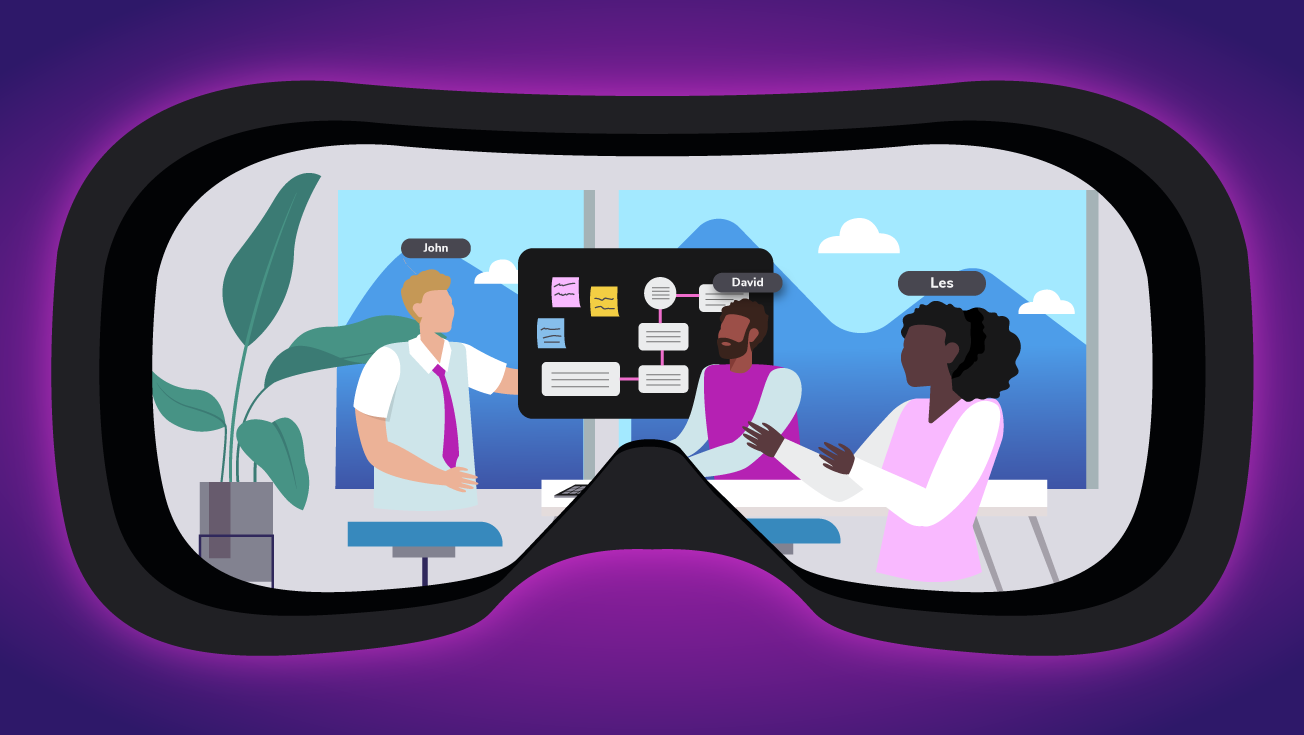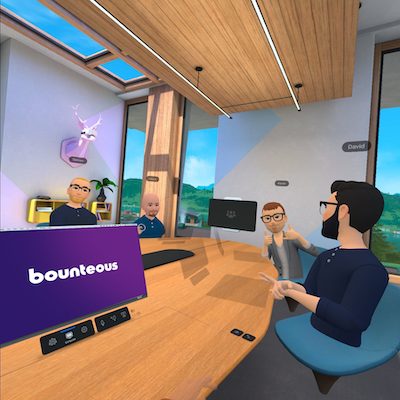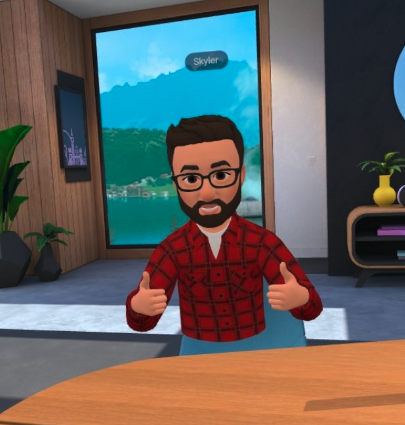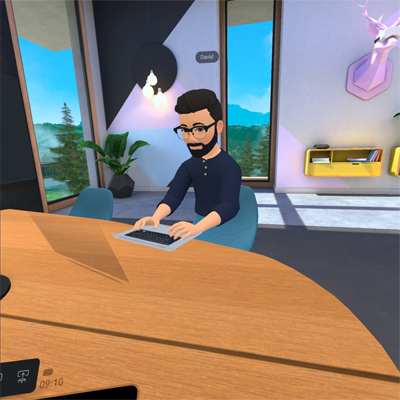The Pros and Cons of Collaborating in the Metaverse

For those that are unfamiliar with the term "Metaverse," it’s a trending term that encompasses the idea of having a digital world that spans multiple platforms and allows people to have a persistent online identity. You can create a digital identity (commonly referred to as an avatar) that you can use across multiple experiences, from socializing, to shopping, working, gaming, or watching live concert events with friends.
You can read our full overview of the Metaverse here: What Is a Metaverse?
There are a lot of different interpretations of what the Metaverse is and what it will be, but one thing most have in common is that it is a real-time, ever-changing, and immersive world. Most will experience it via Augmented Reality glasses (AR) or Virtual Reality headsets (VR), but it isn’t just limited to AR and VR.
Collaborating in the Metaverse
More recently some of the big names in tech—Meta with Horizons Workrooms and Microsoft with Mesh—have been looking to bring the Metaverse to work via virtual collaboration solutions using AR and VR. Instead of starting a video call or sending a message to a colleague you can meet in the Metaverse where you both have an avatar and a space to work together on a solution.
Working remotely has been extremely popular over the last few years and will likely continue to be an option for a lot of people in the years to come. Companies are looking at solutions that bring back some of the benefits of meeting in person by leveraging the immersive benefits virtual reality has to offer. These environments enable you to talk, whiteboard ideas, and manipulate objects together as if you are in the same physical room.
There are some good benefits of these virtual collaboration solutions, but there are also some things that make them less ideal of a solution.
Metaverse Pros
Immersion and Shared Environment
Due to the fact a lot of these solutions are in virtual reality it creates a fully immersive experience. No longer do you feel like you are sitting in your makeshift home office but instead, you feel like you are in a well-designed meeting room. Participants can interact with the same environment by drawing on a whiteboard and moving around objects. It creates a memorable bond and experience compared to individuals looking at their separate monitors.
In the Moment Engagement
You are no longer presented with a single flat-screen view filled with camera feeds (or profile pics of those with the camera off) but instead, have virtual versions of your colleagues around you. People will look in the direction of the presenter, nod, or even raise their hand as if they were in a physical space. They are also not looking at different content while facing a camera.
Spatial Audio
Thanks to spatial audio, sound appears to originate from its source. This makes it easier to identify who’s speaking and maintain focus than it is on a conference call or video call where all the sound comes from one direction. When someone on your left starts talking you see everyone turn their head to listen just like in a real face-to-face meeting.
It is possible to have side conversations as the further away you are the quieter the audio. Making it easier for smaller groups to break off and have a conversation without the need of spinning up breakout rooms or starting new video calls.
Always Dressed for the Occasion
Because it’s your digital avatar you don’t have to worry about how comfortable you might be dressed, if you look like you just woke up, or if you just aren’t feeling well and don’t want to be on camera. Several collaboration solutions give you a lot of flexibility regarding how you want to present or express yourself in these environments. This means you present the best digital representation of yourself at all times.
Tools Are Getting Better
Some of the solutions out there allow you to bring your CPU into the environment. With hand tracking and with the proper setup you can type almost as well as you can in the real world because your actual hands are touching a real keyboard and you can also see these in the virtual world.
Seeing others talk in VR is becoming more and more believable along with natural-looking eye blinking. Hand gestures and body tracking is also giving more life to digital representations of people, allowing them to be more expressive. Although a lot of these solutions provide cartoon-like avatars, there are enough real-world cues to remind you that you are talking to a real person.
Metaverse Cons
Hardware
To participate in the full experience additional hardware is needed. Virtual reality hardware has come down a lot in recent years and is more accessible to the general public, but still is an additional purchase for companies as it isn’t a device that is already built into their day-to-day workflow, unlike laptops and cellphones.
There is also a lot of skepticism around the quality and immersive experience provided by the hardware due to earlier exposure to VR. Not to mention no matter how good or lightweight the hardware gets…it will still be an additional device you have to wear.
Privacy and Security Concerns
There is a lot of concern around security and privacy in these spaces. Some of the big companies looking at building virtual collaboration solutions make their money by advertising and/or selling user information. This creates a lack of trust for companies having private internal meetings.
Another thing to consider is screen recording. Similar to how users can record their screen when on a video call this can be done in these Metaverse collaborations too. Although you may have some control over when your computer screen is shared in the environment, hand tracking is good enough that you can playback a video of someone typing and use it to figure out keystrokes which can lead to compromised passwords and security.
Not the Same Experience for Everyone
Some people can’t participate in VR due to physical limitations. Some are subject to motion sensitivity, vision impairment, or other circumstances that prevent them from being able to wear a headset and be fully immersed.
Most solutions provide a video chat solution to bring in non-headset-wearing participants but that creates separation and differentiated experiences. Often they are passive observers that can’t use a lot of the tools within the environment or encounter major difficulties trying to use these interfaces in 2D.
Lack of Access to the Real World
Although some solutions are bringing in the ability to use your computer in these virtual spaces there is still a lot more you are used to having access to in the real world you just can’t in VR. For example, simple things like drinking a glass of water can be difficult wearing a headset when you can’t see where the glass of water is in the real world and your glass hits the headset as you try to take a quick sip. Your phone is also difficult to interact with while wearing a headset. Not to mention how odd it looks to others when you try to interact with real-world objects.
Unintentionally interacting with real-world objects can be another concern and might be hit by accident like that glass of water you couldn’t drink, a pet, or someone else in the same physical room. Also due to how believable the experience is, you may try to lean on a virtual counter or think there isn’t a wall where there is one in the real world.
The Future and Is It Worth It?
These tools will get better over time just like the hardware has been getting better (and more affordable). With big names like Meta and Microsoft investing in this, there will be more companies trying to create the perfect solution and ultimately leading to even more innovation in this space. We love any product that can help boost collaboration and interest among our team members—so of course we’re experimenting with our our own virtual collaboration center for team members to gather and interact.
For remote teams, collaborating in the Metaverse is a drastic upgrade to video conference calls and a lot of the cons can be worked around or aren’t that big of a deal. But for others, it can be seen as unnecessary or more of a hassle than it is worth. It comes down to what is best for each team and whether it provides more value and improves collaboration.
This post comes from the Bounteous Innovation Lab, tasked with exploring technologies and trends that can help our clients improve user experiences, attract new customers, and foster creativity and collaboration.






